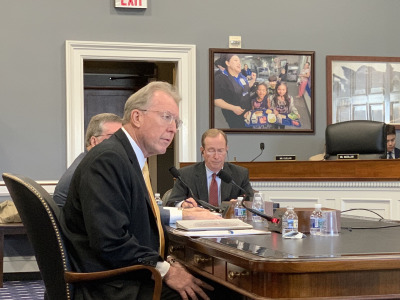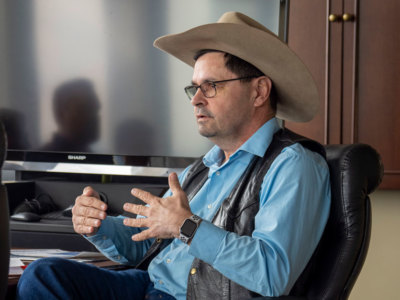Agricultural lenders in the Farm Credit System must have a plan of action on how they will service and enhance their relationships with young, beginning and small (YBS) farmers as part of a rule approved this fall by the Farm Credit Administration board.
The rule — five years in the making — is a capstone achievement of FCA board member Glen Smith, who served as chairman from 2018 to 2022. While being vetted for his confirmation, Smith told Agri-Pulse he heard concern from members on both sides of the aisle about the advancing age of farmers and ranchers in this country — the average age is nearing 60 years old — and a strong desire to help those entering agriculture.
Board Chairman and CEO Vincent Logan said during his confirmation proceedings he also heard about the importance of improving service to YBS producers. Smith said Logan “contributed his unique perspective and leadership, particularly in the area of outreach to underserved groups,” in the final rule which will become effective in February.
“It’s a rule of opportunity for generations to come,” Smith said, setting up the ability to give new and beginning farmers a firm footing to start their agricultural careers. “If times turn tough, [banks] don’t necessarily have to be in agriculture, particularly for higher risk loans like a YBS might represent.”
The new requirements — specifically enhancing the YBS strategic plan at each direct-lender association — create accountability and provide an opportunity to share success stories of what works around the country, Smith added.
In the wake of growing concerns over the stability of financial institutions, Smith called the YBS rule “something positive coming out of the agricultural financial regulator that’s building for the future.”
While the FCA board was considering the final rule, Jessica Potter, a senior policy analyst in FCA's Office of Regulatory Policy, explained the “final rule requirements will add consistency to longer-term planning and program development at each direct lender while also requiring a review of program components, all of which should strengthen the direct lenders YBS program.”
 Glen Smith, Farm Credit Administration (left)The Farm Credit System, which provides around 45% of the nation’s total farm debt, made $13.1 billion in loans to young farmers in 2022, $21.5 billion to beginning farmers and $19.1 billion to small farmers.
Glen Smith, Farm Credit Administration (left)The Farm Credit System, which provides around 45% of the nation’s total farm debt, made $13.1 billion in loans to young farmers in 2022, $21.5 billion to beginning farmers and $19.1 billion to small farmers.The new rule also requires annual review and approval of a lender's YBS programs, but FCA didn’t try to dictate how institutions should go about improving their YBS plans.
“One size doesn’t fit all,” Smith said. “We simply say, 'Come up with a plan that's custom fit to your area.’”
As FCA leaders traveled around the country, Logan and Smith shared firsthand how lenders are working with YBS lenders and partnering with USDA’s Farm Service Agency to create successful outcomes.
Smith said there was an elevated level of success — particularly increased loan activity and fewer distressed loans — among YBS programs with a high degree of participation and coordination with local FSA offices, especially with the delivery of USDA’s guaranteed loans.
In one of his first trips to North Dakota, Smith discovered a high level of cooperation, active communication and a “streamlined process for YBS loans” between the local FSA loan officers and the local Farm Credit institutions.
FCA also conducted three different seminar events in cooperation with FSA to encourage and work on delivering a more efficient process of loans and delivery of those guaranteed loans to conventional lenders and Farm Credit system institutions as well as community banks.
FSA Administrator Zach Ducheneaux told Agri-Pulse he wants to educate lenders on the tools and terms available to help producers. He said FSA is somewhat limited on what staff can say directly to producers when they walk in the door, but they can help work with cooperators and organizations who can also help educate individual producers on what they should be asking of their lenders.
The other key to success for YBS programs is a higher degree of loan officer involvement that offers those YBS farmers everything from financial management to marketing insight, Smith said.
Smith pointed to an Asheville, North Carolina, program that brought in young, beginning and small farmers for a weeklong crash course in agricultural financing and offered insight on everything from marketing and financial planning to communication with the lender.
“My hope is the enhanced requirements of YBS will encourage system institutions to share those successes and best practices in serving YBS producers,” Smith shared during the vote.
YBS a focus of FSA and additional lending institutions
Ed Elfmann, senior vice president of agriculture and rural banking policy at the American Bankers Association, said it’s been a priority of their lending institutions to have beginning farmer lending in their portfolios.
Rural communities need young and beginning farmers to choose to stay and not move away, something Elfmann said can be difficult to do without YBS programs in place.
ABA institutions, which represented approximately 40% of all agricultural credit in 2021, also recognize a beginning farmer is a great client to bring into a local bank because he or she can become a lifetime customer.
“If you work with them on the front end and make sure that they’re taken care of and able to do what they need to do, that helps develop potential lifetime relationships,” Elfmann said.
Both Ducheneaux and ABA identified efforts to improve the loan process, which could be especially helpful for young and beginning farmers.
Ducheneaux said FSA is evaluating how to streamline access to the loan program, reduce the length of the applications, and develop an online application process that will be rolled out more broadly this month. FSA is also piloting a fast-track application approval process with planned expansion in 2024.
“One of the challenges that we have to try to navigate is this rigor that we’re expected to use in our underwriting, and balancing that with the need for a young and beginning producer” who may be a first-generation farmer or doesn’t have a family connection in farming, Ducheneaux said.
He’s exploring whether a prequalification or preapproval process similar to the mortgage market could be replicated that meets FSA's statutory requirements for loan review and documentation.
 FSA Administrator Zach DucheneauxIf an opportunity — such as land for sale — becomes available to YBS producers, “they’ve got to be able to shop and strike while the iron is hot,” Ducheneaux said.
FSA Administrator Zach DucheneauxIf an opportunity — such as land for sale — becomes available to YBS producers, “they’ve got to be able to shop and strike while the iron is hot,” Ducheneaux said.Farm bill changes can also help aid YBS borrowers
ABA continues to advocate for higher FSA loan limits, possibly making the change within the 2023 farm bill update to ensure FSA matches how the cost of agriculture is going up.
ABA sought a $3.5 million threshold for guaranteed farm ownership loans in the last farm bill, but didn’t get it. Elfmann said they’re seeking that level again, as well as $3 million for operating credit line loans.
“We believe that will give us the flexibility to really work with folks going into the future, and just trying to stay on track with how the cost of agriculture continues to go up,” Elfmann said.
It’s easy to be “in the know” about what’s happening in Washington, D.C. Sign up for a FREE month of Agri-Pulse news! Simply click here.
The Farm Credit System and ABA have also been working together to shed light on how some agricultural operations are structured can affect YBS borrowers.
For example, if the great-grandfather of a young borrower put a farm in a trust, that structure can make it much more difficult for a beginning farmer or rancher to secure an independent loan if the individual attempts to use the land in the trust for collateral. Children in a parent-child partnership with one farm identification number could be prevented from acquiring an FSA beginning farm or ranch loan.
ABA and Farm Credit institutions believe the beginning farmer and rancher loan program should focus on a “bona fide operator,” but fix the language to allow for those unique structural situations.
Elfmann said ABA is also pursuing a fix to the Downpayment Assistance Program at USDA, which was not indexed to inflation the same way that other programs were. The recent rise in interest rates has also highlighted the need to change the Interest Assistance Program through possible targeted assistance for beginning or disadvantaged borrower groups to keep costs down.
“Now that interest rates are on their way back up, we want to make sure that if a guaranteed borrower needs interest assistance, they have access to it,” Elfmann said.
Although not likely to make its way into the farm bill, another major piece of legislation championed by ABA is the Access to Credit for our Rural Economy Act (ACRE), which would remove the taxation on income from interest earned on farm real estate, rural housing and aquaculture loans.
“The biggest cost for any beginning farmer is land. The ACRE Act levels the playing field across the board for anybody doing agricultural lending,” Elfmann said.
For a beginning farmer, it would help lower their costs 50 to 150 basis points, “and that’s real money if you’re living in the margins as a beginning farmer,” Elfmann said.
For more news, go to Agri-Pulse.com.


